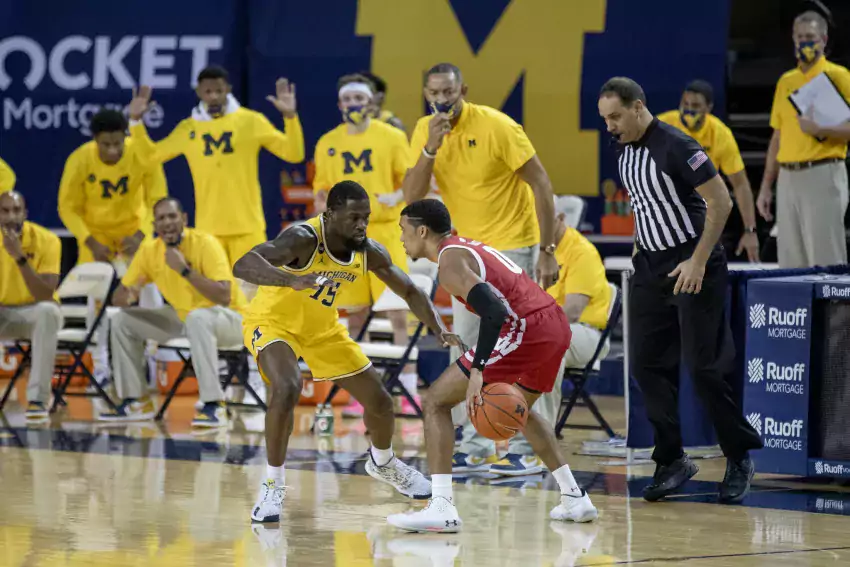
Basketbullets Lives In Your Shirt

Michigan stuffed Wisconsin's 11th-ranked KenPom offense into a trash can on Tuesday. The Badgers shot 11-for-37 on two-pointers, got to the line only six times, and recorded eight assists against ten turnovers. Of their 12 offensive rebounds, five were the knocked-out-of-bounds team rebound variety, which doesn't pose any putback danger. They went stretches of 6:37 and 7:26 without scoring—that's getting blanked out for 35% of the game.
The Wolverines laughed at the idea of potential mismatches. A big guard against M's small backcourt? Brad Davison posted up Mike Smith on UW's second possession, hurled up a brick, and proceeded to go 1-for-8 for two points, his lowest scoring output in almost a year and the third-worst game of his four-year career by O-Rating. D'Mitrik Trice scored five points in the first three minutes, then two more for the rest of the half, and the Badgers were down 33 points by the time he got on the board in the second.
The primary worry heading into the game was that Hunter Dickinson would have trouble with a pair of legit stretch fives. Wisconsin's center duo of Micah Potter and Nate Reuvers combined for 16 points on 7/20 shooting with zero trips to the line, zero assists, and five turnovers. So much for that.
Michigan boasts the nation's #1 two-point defense and are tenth in KenPom's adjusted defensive efficiency. Using the Wisconsin game as a lens, let's look at how Juwan Howard has created this monster.
You Can't Run
Scoring on the fast break is obviously easier than scoring in halfcourt. A team can get a lot of their defensive work done early by getting back. This has to be demoralizing:
Michigan gets back. Wisconsin scored two fast break points on Tuesday even though they recorded four steals. I need a college stats site to start tracking chasedown blocks:
The plays that don't show up in the highlight reel are even more important than the Tayshaun-on-Reggie moments. Despite often holding massive leads, they've had very few lapses. Only 3.3% of initial opponent field goal attempts against Michigan occur in the first ten seconds of the shot clock following a made Wolverines basket, the fifth-best mark among high-major teams, per hoop-math. They communicate, find their matchups, and don't lollygag.
The team's size and versatility helps too; if, for example, Dickinson is caught upcourt after a tough finish, Wagner can be there to pick up the opposing center for a few seconds while the team settles back into their matchups. When teams attack cross-matches early in the shot clock, they find it tough to score. Here's Chaundee Brown forcing Nate Reuvers into a tough fadeaway:
It would've been better for Wisconsin if Reuvers had given that up instead of forcing the action. That often happens against Michigan. According to Synergy, M faces transition possessions only 12.6% of the time, the fourth-lowest rate in the Big Ten, a conference not exactly known for permitting easy fast break buckets.
[Hit THE JUMP before someone blocks it.]
So You Have To Face The Halfcourt Defense
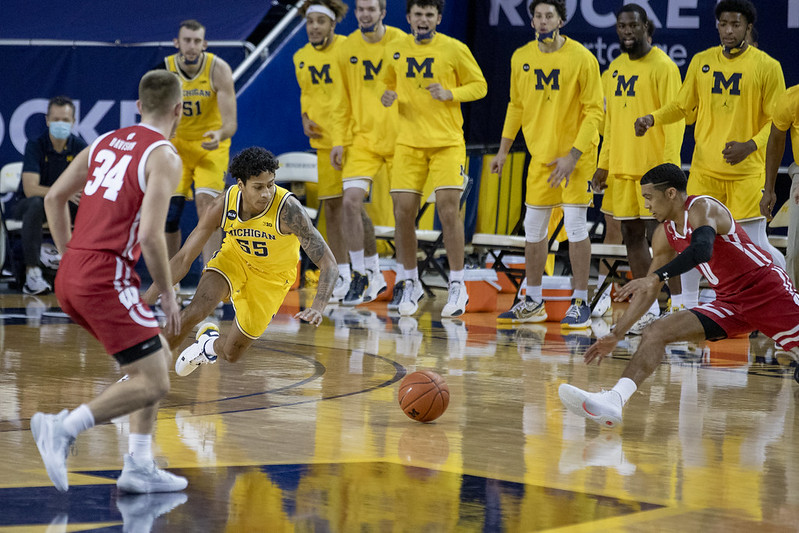
Eli Brooks would be many teams' best defender [Campredon]
You're in for a rough time. These are Synergy's halfcourt defensive stats for Big Ten teams (all games included), sorted by points per possession allowed. The other stats: percentage of possessions faced in halfcourt, effective field goal percentage, turnover rate, percentage of plays ending in free throws, and percentage of plays ending in any kind of score.
| %Time | PPP | eFG% | %TO | %FT | %Score | |
|---|---|---|---|---|---|---|
| Wisconsin | 89.9 | 0.785 | 42.7 | 15.7 | 10.3 | 36.1 |
| Michigan | 87.4 | 0.790 | 41.9 | 13.2 | 8.5 | 34.9 |
| Indiana | 86.3 | 0.797 | 44.9 | 17.0 | 11.5 | 36.9 |
| Iowa | 81.9 | 0.799 | 45.6 | 15.5 | 9.0 | 35.5 |
| Illinois | 86.0 | 0.824 | 44.6 | 13.0 | 12.1 | 38.2 |
| Minnesota | 88.2 | 0.841 | 45.9 | 15.2 | 12.6 | 39.4 |
| NW'ern | 89.3 | 0.844 | 47.2 | 16.1 | 11.5 | 38.3 |
| OSU | 86.5 | 0.857 | 46.2 | 13.3 | 13.4 | 39.2 |
| Purdue | 86.1 | 0.862 | 47.9 | 14.7 | 13.2 | 38.9 |
| Nebraska | 85.8 | 0.863 | 49.0 | 16.1 | 11.7 | 38.7 |
| MSU | 86.0 | 0.889 | 46.9 | 13.1 | 12.7 | 40.3 |
| Maryland | 86.1 | 0.891 | 48.8 | 12.5 | 10.4 | 39.7 |
| Rutgers | 83.9 | 0.900 | 49.8 | 15.6 | 13.4 | 41.2 |
| PSU | 84.8 | 0.977 | 54.2 | 17.1 | 17.1 | 44.8 |
Thank you to Iowa for demonstrating the importance of both schedule strength—the best Big Ten offense they've faced is Rutgers—and keeping teams out of transition. While they're close behind the Wolverines in halfcourt points per possession allowed, they lag well behind the rest of the conference in percentage of the time those plays happen.
Anyway, Michigan forces their opponents into halfcourt sets more than any Big Ten team other than Wisconsin, Northwestern, and Minnesota. In halfcourt play, they rank first in the league in opponent eFG%, lowest rate of free throws allowed, and percentage of possessions ending in a score; they're second in PPP allowed, only ranking that low because they don't force many turnovers. The mark of 34.9% of opponent halfcourt possessions ending in a score is tenth-lowest among high-major teams in the country.
The Rim is a Fortress
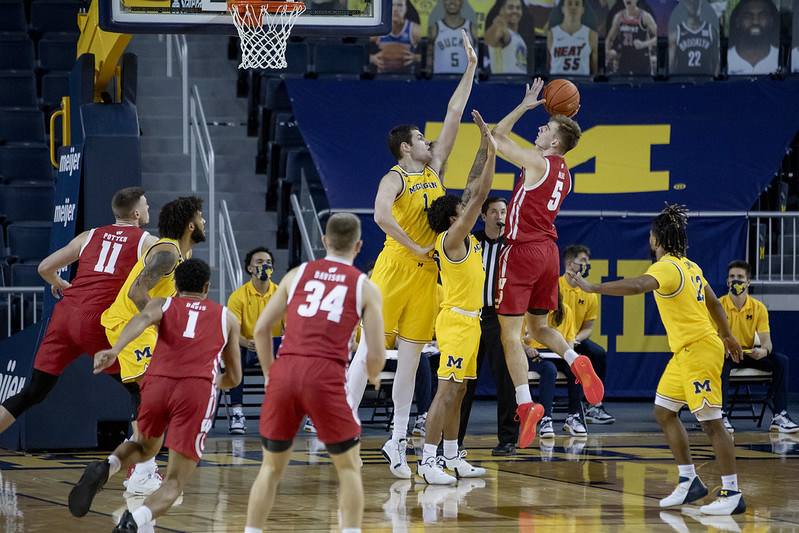
walled up [Campredon]
This is the team's nominal small forward stuffing Wisconsin's all-time leading shot-blocker to end a play designed to attack this matchup on the very first possession:
Michigan ranks first in the Big Ten and 17th nationally in block rate even though they don't have an individual player inside the top 100 in that stat—Dickinson is closest at 107th. While Dickinson isn't among the elite in block rate, he's not chasing them so much as walling up and letting his huge frame do the work, even if that means sacrificing stats.
It's a team effort: Wagner, Livers, and Chaundee Brown are all nationally ranked, and Brandon Johns would be closest to Dickinson if he played enough minutes to qualify for the rankings. Even Eli Brooks adds some weakside shot-blocking; his 1.1% block rate is good for 44th in the Big Ten and third-best among players shorter than 6'4.
The Wolverines make it hard to get to the rim in the first place. They face the lowest percentage of shots at the rim in the conference, per hoop-math, and push an astonishing percentage of shots into two-point jumper range—they're way ahead of every Big Ten team except Illinois in that regard.
| % shots at rim |
FG% at rim |
%blocked at rim |
% shots 2pt J |
FG% 2pt jumpers |
%blocked 2pt jumpers |
|
|---|---|---|---|---|---|---|
| Michigan | 24.1 | 58.6 | 5.9 | 39.2 | 25.8 | 14.9 |
| Nebraska | 24.9 | 59.2 | 8.7 | 31.1 | 43.5 | 8.3 |
| Purdue | 25.8 | 72.3 | 5.1 | 28.6 | 33.8 | 8.3 |
| Illinois | 27.0 | 57.7 | 9.9 | 39.0 | 35.7 | 4.9 |
| OSU | 28.8 | 59.4 | 12.0 | 33.7 | 32.3 | 7.1 |
| NW'ern | 29.7 | 54.4 | 9.2 | 28.9 | 41.6 | 2.6 |
| Wisconsin | 32.9 | 54.1 | 14.0 | 33.6 | 33.5 | 4.8 |
| Maryland | 34.7 | 59.9 | 9.5 | 26.8 | 36.9 | 8.0 |
| MSU | 35.1 | 59.0 | 11.6 | 29.3 | 31.9 | 11.4 |
| Indiana | 35.3 | 56.2 | 13.9 | 27.1 | 33.8 | 9.7 |
| Iowa | 35.4 | 51.8 | 15.1 | 24.7 | 36.2 | 5.6 |
| Minnesota | 37.7 | 57.2 | 13.5 | 30.6 | 33.6 | 8.1 |
| Rutgers | 37.8 | 56.5 | 17.5 | 26.0 | 39.1 | 5.3 |
| PSU | 47.4 | 63.0 | 10.3 | 17.5 | 41.2 | 5.9 |
You can see a pattern at the rim: teams that go for rim blocks tend to give up a high percentage of shots near the hoop. When Michigan players are near the restricted area, they focus more on getting their arms vertical and maintaining strong positioning, a significant factor in M having the country's fifth-lowest foul rate. Most of the other teams with extremely low foul rates are giving up a lot of easy baskets; not so in this case, obviously. Even Smith is making it tough at the hoop because of his positioning and strength.
I've also buried the lede in this section. Not only is Michigan forcing 39.2% of opponent shots to come from the dreaded two-point jumper range, they block 14.9% of those shots, third-best in the country behind only Hampton and Kentucky. The 25.8% shooting mark allowed from that range is also second-best among high-major teams.
Hoop-math's data is pulled from play-by-play, so the definition of a rim attempt is relatively tight—essentially the restricted area—so these aren't all pull-up jumpers by any means. Given how these eight-foot prayers in traffic are going, though, it might behoove opponents to take more 18-foot jumpers. It's something different, at least. Then again...
Jumpers Aren't Open
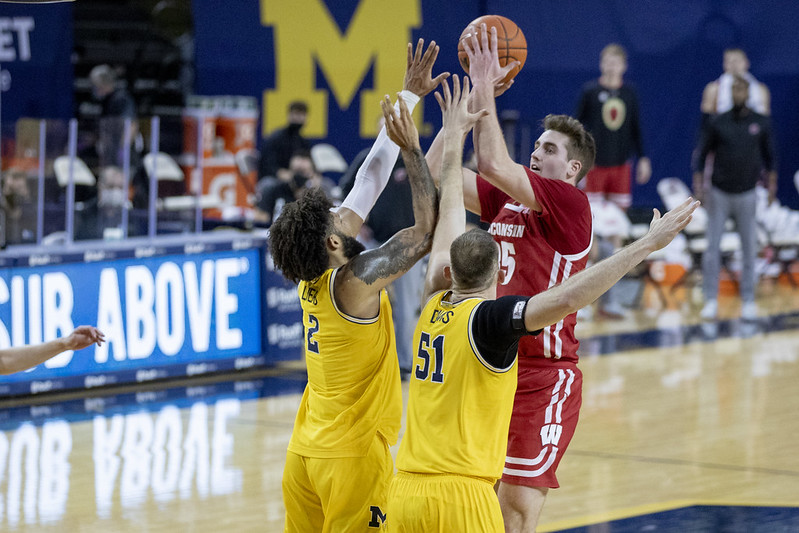
somewhat contested [Campredon]
Synergy puts jump shots into two buckets: guarded and unguarded. That's straightforward enough. Even though it felt like Wisconsin got off a decent number of uncontested three-pointers in this game, those take on outsized importance in our minds because Michigan defensive breakdowns are so rare. Even though they're making the paint impenetrable, they're also contesting most shots outside of it, too.
Here are Big Ten teams against unguarded jumpers, sorted by the lowest percentage faced out of total jump shots:
| %Time | FGM | FGA | eFG% | |
|---|---|---|---|---|
| Minnesota | 25.9 | 23 | 56 | 60.7 |
| Michigan | 32.9 | 15 | 56 | 39.3 |
| Wisconsin | 33.0 | 23 | 60 | 55.0 |
| Indiana | 34.7 | 18 | 70 | 37.1 |
| MSU | 35.4 | 27 | 58 | 69.8 |
| Maryland | 41.4 | 31 | 92 | 49.5 |
| Illinois | 41.6 | 30 | 79 | 56.3 |
| NW'ern | 42.9 | 34 | 93 | 52.2 |
| Iowa | 43.4 | 41 | 109 | 55.0 |
| OSU | 45.4 | 44 | 104 | 59.6 |
| PSU | 46.5 | 18 | 46 | 58.7 |
| Purdue | 48.2 | 51 | 133 | 56.8 |
| Nebraska | 49.8 | 47 | 127 | 54.7 |
| Rutgers | 52.0 | 37 | 93 | 58.6 |
Only Minnesota is better at contesting jumpers and they appear to be sacrificing defensive rebounding to do so; they're dead last in the Big Ten on the boards while the Wolverines are sixth and significantly better by the numbers (24.8 opponent OR% to 32.2%). There's a big gap between the top five and the rest of the league, too.
Yes, Michigan is due for regression in eFG%, because other than leaving the right player open—which only accounts for some of these shots—there's no control over whether an unguarded shot goes in. The bottom of the list indicates that number should eventually settle in the 55-60 eFG% range with a large enough sample. That said, we're talking about a handful more three-pointers going in over the course of the season.
Brooks did a fantastic job defending Trice on Tuesday night. Even when receiving screens and handoffs, Trice had a really difficult time getting separation, and that resulted in a number of contested jacks:
Michigan rarely blows rotations, they're quick to recover onto shooters after helping down low, and they have players who can blow up off-ball action. I've reserved the right to include a non-Wisconsin GIF because this play by Wagner is bananapants:
That's a technical term.
Turnovers Don't Capture Their Disruption
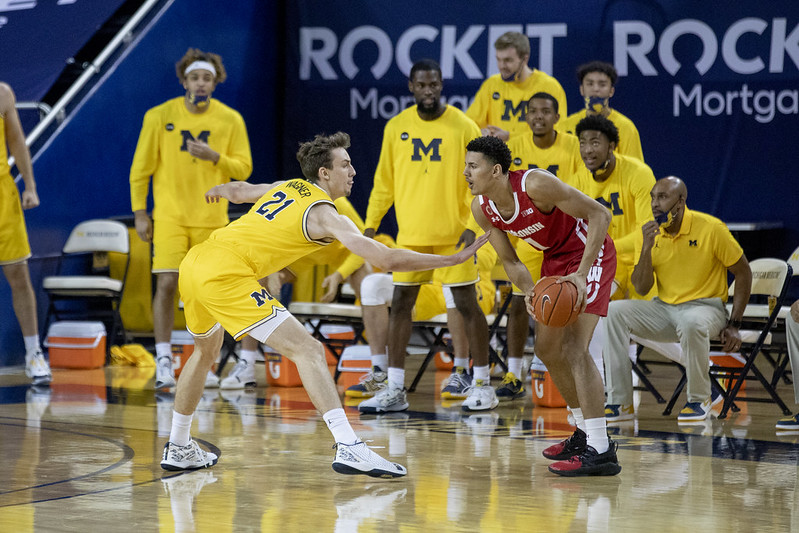
more swats and pokes than yoinks [Campredon]
Wagner leads a nightmarishly long group that doesn't gamble for steals but still creates plenty of havoc. A lot of it never shows up in the box score. Wagner shuts down this Aleem Ford drive even though he has a lot of momentum from a dribble handoff, pokes the ball away, and forces a total reset of the offense with half the play clock burned off:
He helped off his man to whack the ball out of bounds and turn a promising drive into a sideline out of bounds with half the shot clock gone again. He did the same thing to prevent a hard baseline drive from turning into a kickout corner three, again with half the clock burned. Isaiah Livers almost jumped a pass, turned it into heavy pressure on Wahl, and poked the ball out to force a sideline out of bounds set at 12 seconds:
That has to be demoralizing and annoying, especially when Wagner claps for ten seconds after the ball goes out of play.
The Worst Plays Are Your Best Plays
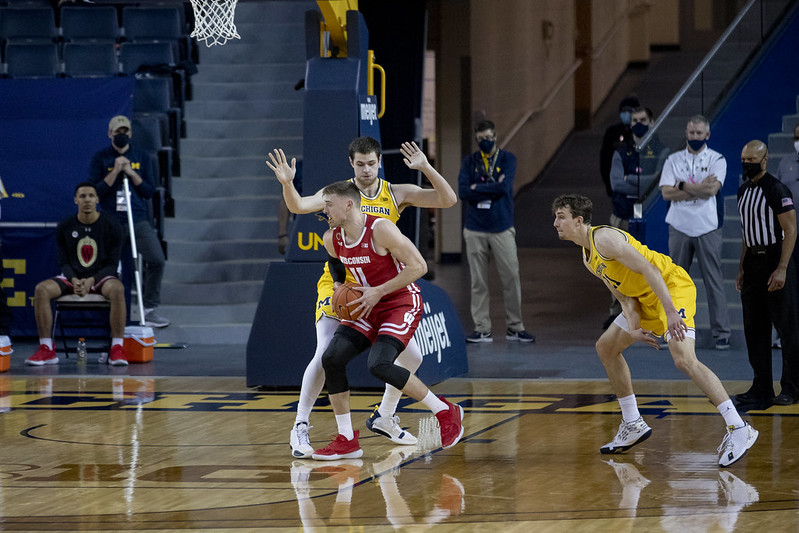
might as well [Campredon]
Michigan is 17th among high-major teams in PPP allowed against the pick-and-roll. They're merely quite good at post-up defense and only average defending isolations, but since those aren't high-efficiency plays on average, they're barely more effective than the screens this defense demolishes. These numbers from Synergy include shots off the initial pass from each set:
| % Time | PPP | %ile Rank | eFG% | %TO | %FT | %Score | |
|---|---|---|---|---|---|---|---|
| Isolations | 9.9 | 0.793 | 46 | 37.5 | 6.9 | 11.5 | 35.6 |
| Pick & Rolls | 32.9 | 0.747 | 83 | 31.5 | 10.0 | 7.3 | 32.2 |
| Post-Ups | 5.2 | 0.783 | 73 | 42.1 | 8.7 | 8.7 | 41.3 |
But there's more! This defense seemingly encourages the pick-and-roll, facing it a higher percentage of the time than all but three Big Ten teams. They also force teams into the second-most isolation plays in the league. Meanwhile, they've seen easily the fewest post-up possessions in the conference.
I suspect a lot of that is because Michigan tends to nerf initial actions by opponents, which sends them into their default late-clock play—which for most teams is a quick high screen or a clearout. The parade of batted balls in the last section points in that direction. The inbounds play after Livers hounded Wahl at halfcourt broke down into a Micah Potter isolation drive into Dickinson's chest:
That's a tough way to live.
So is this, though. After a little early success, Trice couldn't free himself from Brooks on pick-and-rolls or dribble handoffs, taking a bunch of tough pullups because Dickinson loomed in drop coverage:
Smith had his success defending the pick-and-roll as well; he's improving in a number of areas, and I'm guessing it helps that he knows he can trust his teammates. Trice's attempt to go at Wagner ended... poorly:
Very poorly.
Michigan allows the lowest rate of assists on made baskets in the conference and the 15th-lowest nationally. In Big Ten games, only 39.7% of field goals have been assisted. To score on the Wolverines, you usually have to go it alone, and you'd better be able to score outside the structure of the offense.
The Changeup Has Movement
Howard liked to use a basic 2-3 zone out of timeouts in his first season as a way to throw off opponents. This year, he's taught the team enough to play exotic variations, in particular a 2-3 that morphs into man. It's not easy to predict what triggers the switch, either. On this possession, which occurs in front of the Michigan bench, it seems to be a backcut that's picked up by Eli Brooks:
This play swaps from man to zone as soon as Tyler Wahl (the zone-beater, for some reason) flashes to the high post:
On this play, the cue again is the pass to the high post, and with Potter determined to go at Dickinson one-on-one, Wagner is free to roam and swipe the ball:
Michigan will run zone for stretches now instead of limiting it to the first play or two out of a timeout. While they still don't play it often—only 2.6 possessions per game, according to Synergy, though I'm not sure how they treat the morph to man—they look more comfortable with the basic principles and how to bend them to stop the usual zone-beaters. This is a beautiful read by Brooks to stray all the way from his near-side zone at the top of the key to the opposite elbow and steal the pass to the high post that initiates most 2-3 zone-beaters:
Howard can also unleash Brown, have him press the opposing point guard, and burn a third of the shot clock away while everyone else gets a little break:
Throwing out a soft press got Wagner a pick-six before the broadcast was prepared for action. On the next play, the press forced Wisconsin to start their set late, Trice seemed out of sorts, and Brooks created a loose ball that Smith turned into a layup.
We've seen Howard throw out wrinkles to his pick-and-roll coverage, like ending Northwestern's five-out offense by icing screens or confounding Minnesota's Marcus Carr with a couple well-executed hard hedges from Dickinson. Even though he prefers sticking to his base defensive principles, he's adaptable when needed, and so is his team. They look exceptionally well-coached in a season of limited preparation and practice time. Perhaps the scariest aspect of this defense is that it appears to have upside left to explore.
Big Picture Takeaways
Holy shit! I cackled through most of this writing process. I nearly fell out of my chair when I went to Synergy's shot chart app, cut it down to games against the Big Ten and Toledo (68th in KenPom), and pulled out the plays against the bench mob. Please note this app only has three color-coding options and the one that makes my brain hurt the least for defense goes from gray (good shooting) to blue (poor shooting). They helpfully add the option to include FGM/FGA and percentages for each area:
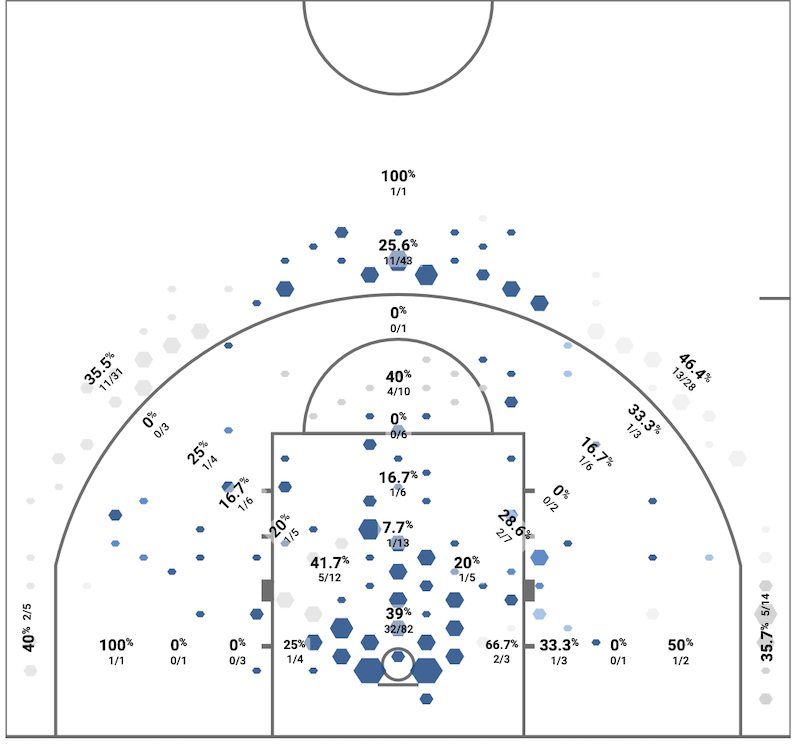
Holy shit! Below 40% at the rim! Only 19 corner three-point attempts in seven games! A lot of shots from floater range that almost never go in! Almost everything is forced to the middle! This post might need a NSFW warning! I'm using too many exclamation points! Or maybe not enough?!?!
There are very few weak points. You may have noticed that every player in Michigan's top seven had a starring role in at least one of the plays embedded above. Wagner is one of the best all-around defenders in the country; Brown and Livers are versatile perimeter nightmares; Dickinson is a massive rim presence with more mobility than expected; Brooks lives in his man's pocket; Smith is getting more settled in by the game; Johns is a legitimate shot-blocker who can switch through multiple positions or play drop coverage at center.
Offenses can try to get the right matchup on Smith, hope to overwhelm the backcourt with size, or see if they can be the team that finally has the stretch five shooting performance that puts Dickinson on the wrong end of a mismatch. Most of that hasn't worked in a way that's sustainable, and if it does, Brown and Johns are waiting on the bench. Otherwise, you're hoping Austin Davis plays a long enough stretch to get a couple post-up buckets on him and maybe even a successful pick-and-roll or two.
This looks sustainable. Wisconsin was supposed to be the major test of Michigan's legitimacy and, well, consider it passed. The Wolverines aren't relying on generating a high number of turnovers (quite the opposite) or unsustainable three-point luck (again, close to the opposite) or hanging on for dear life on the boards or catching the right matchup because they can only play one way or hoping their best players stay out of foul trouble.
That last bit will be tested at some point. Probably. Dickinson's skill at walling instead of bringing his arms down, in conjunction with the officiating emphasis on verticality plays at the rim, means he's only committing 2.8 fouls per 40 minutes. He's committed one in the last three games—combined. He's had four fouls in a game once all year and three just twice, one of them the opener and the other when he got a technical (which in college also counts as a personal) for repeatedly taunting Maryland's bench.
In the eventuality that Dickinson gets into foul trouble, opponents may not even get much of a break if Johns remains the primary backup center. In that B1G+Toledo sample, he's played about a game's worth of possessions at center, and they've gone very well, per Hoop Lens:
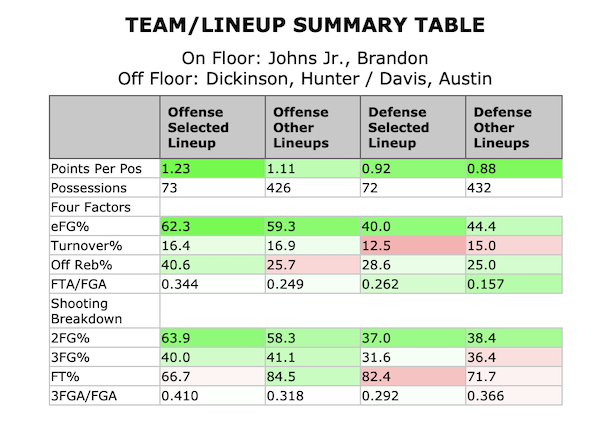
Michigan's two-point defense doesn't fall off at all with Johns on the floor. I'm sure some of that is Howard picking the right spots but he's also let Johns stay out there against some starting big men and he's held up well. The return of Davis lets Howard unleash Johns at power forward, which also has a lot of upside, so I'm guessing the Johns-at-center lineups are a matchup-based changeup for the most part going forward, but those groups could play a major role when it's time to really tighten up the rotation in the postseason.
They could get better. I know, I know. I'm typing this with some trepidation. Still, this is the #1 two-point defense in the country, and that tends to be a great indicator of overall defensive strength. As I mentioned above, Michigan isn't posting great overall defensive numbers because of luck in peripheral stats.
If anything, they're a little unlucky in those: opponents are hitting 34.5% of their three-pointers, putting M's defense 219th nationally in that regard even though they contest most of those shots, and only 11 teams in the country have seen their foes make a higher rate of their free throws (77.5%).
Meanwhile, Howard hasn't played the scariest defensive lineups much yet. The trio of Wagner, Livers, and Brown have only played 68/504 defensive possessions in the seven-game sample of quality competition. They're allowing 0.75 PPP on 29.5% two-point shooting in that sample. Dickinson has only been on the floor for 37 of those possessions, which drops the PPP to 0.70. Brown and Brooks have been paired in the backcourt without Smith on the court for only 66 possessions (0.89 PPP).
They really could get better.
January 15th, 2021 at 3:11 PM ^
You can see in the cover picture how Zeb has his hands up, like play D with your feet. The coaches have clearly emphasized defense and defensive effort, and the players are bought in. As of typing this, Michigan is only 3 spots below Iowa on Ken Pom in terms of offensive efficiency. They are 59 spots higher than Iowa in defensive efficiency. Indeed, you can have both. And more importantly, need to in order to cut down the nets.
January 15th, 2021 at 3:33 PM ^
No lollygagging around here!
Wow, what a great report, Ace.
January 15th, 2021 at 8:25 PM ^
Wow. That’s a lot of information.
Question for Ace: are you getting paid by the word?
January 15th, 2021 at 3:38 PM ^
This was a fantastic write-up. I wouldn't be surprised if it took quite a bit of time to do. So thank you for this.
January 16th, 2021 at 12:50 AM ^
Seconded! Splendid write-up, and we really appreciate the effort, Ace.
January 15th, 2021 at 3:52 PM ^
OMG, you're right. Wagner, Livers & Brown have been a rare combination AND they're fantastic.
January 15th, 2021 at 4:13 PM ^
The defensive communication and synchronization is what really stands out most to me. It’s amazing, and something I don’t think we even saw to this level in the Yaklich era. How many other teams, even at the NBA level, are capable of executing the zone-that-switches-to-man like this? I watched a lot of the Raptors and Heat last playoffs—probably the two best zone teams in the NBA—and for all the exotic zones they threw out, I don’t remember them even trying one where everyone switched to man mid-possession. Incredibly well-coached team.
Another thing in this vein: they are very good at scram-switching the guards out of mismatches against opposing bigs. This is another factor in their 2-point defense: you can try to scheme up a way to put Smith or Brooks on your big man in the post, but Michigan is very organized at getting them out of that situation before the ball can be entered to take advantage it. The best NBA switching defenses focus on this capability a lot, and Juwan has our boys well-drilled on it too.
January 15th, 2021 at 4:19 PM ^
Among all of the revelations with this team....being elite at defense was the least likely in my off season imagination. Tiny up-transfer PG? Bad for your defense. Freshman center platooning with Austin Davis? Bad for your defense. No true shooting guard because Brooks is built like a PG and Brown is built like a power-lifter? Not ideal for defense. Last year's erratic results, especially against elite post players, in a conference full of elite post players? Yikes.
And yet they seem extremely well coached AND all committed. I think that mini-break around the holidays allowed the coaches to really drill these systems to the players. What is really impressive in addition to execution is just the depth of the playbook on both sides of the ball. I have never seen a team morph from zone to man as seamlessly as this. I swear there were moments late against Wisconsin where Juwan was trying to explain new plays in the middle of a possession just to try something on offense.
January 15th, 2021 at 6:03 PM ^
The only thing more impressive than Juwan’s playbook, is the player’s ability to learn and execute it. Pretty good for a bunch of college kids with limited practice time.
Meanwhile, we see players on other teams having trouble executing basic switches or rotations. We have it so good.
January 15th, 2021 at 4:28 PM ^
I love that you pointed out Wagner's clapping after the ball goes out of bounds or a defensive foul is called. For some reason that is so hilarious to me and has to be extremely annoying for opponents.
January 15th, 2021 at 4:43 PM ^
Could the shot clock be what triggers the zone-to-man switch?
January 15th, 2021 at 4:45 PM ^
I looked for that and couldn't find a pattern. I think it's triggered by certain actions.
January 16th, 2021 at 10:49 AM ^
Ace, as a former college basketball player myself, I’d hearken to your own statement regarding the supposed zone to man morph. Michigan is comfortable with “bending the rules” of a 2-3 zone to stop the zone beaters. The second clip illustrates this idea best. Wisconsin attempts to overload one side and Franz reacts by following the cutter to the opposite corner. Eli then replaces Franz’s position in the zone, Mike replaces Eli’s position and Livers replaces Mike’s position. So they’re still in zone at the end. In the third clip, I’d say they remain in zone as well. The only clip where it looks like they for sure switch to man is the first one. In the first one, Eli and Livers are very clearly following cutters instead of passing them off. Just my two cents.
January 15th, 2021 at 4:49 PM ^
The game I'm dreading is the one where the refs get whistle-happy and call things like Brown harassing Trice a foul or reward a guy for flopping when Dickinson turns his shoulder into him. It is coming. I haven't gone this long without complaining about officials in forever. I'm a little worried about the home whistle at Minnesota this weekend.
January 15th, 2021 at 4:50 PM ^
The highlight of the play with Brooks on Trice was watching Hunter box his guy out to the point where he's totally out of the play and about five feet away from being in position to contest for the rebound.
January 15th, 2021 at 5:02 PM ^
"The primary worry heading into the game was that Hunter Dickinson would have trouble with a pair of legit stretch fives. Wisconsin's center duo of Micah Potter and Nate Reuvers combined for 16 points on 7/20 shooting with zero trips to the line, zero assists, and five turnovers. So much for that."
As Brian mentioned in his game recap, it's easy to imagine a different scenario in this game if Potter and Reuvers hit their open threes. The pick and pop generated a number of wide open looks from 3 for those guys. Maybe the game plan was to give them that look until they proved they could make it, who knows. But I think it's fair to say that Hunter's ability to guard stretch fives is still at best uncertain, and will remain so until a big hits a couple of threes in the early going to necessitate more attention. When that happens (and it will eventually, possibly on the return trip to Wisconsin) we'll get a better sense for Hunter's defensive versatility.
In the paint, he is fantastic on offense and surprisingly agile on defense for someone his size. I think we've seen enough to be confident in that.
January 15th, 2021 at 6:38 PM ^
I think Juwan is fine with allowing Wisconsin bigs to shoot 3s until they prove that they can make it. No way that Juwan was going to allow Hunter and Davis to guard out in the perimeter or they'll get burned.
There is a reason why Juwan doesn't allow either Hunter or Davis to switch on defense. If it's Diabate, totally different situation since Diabate has elite athleticism to pull it off.
January 15th, 2021 at 5:30 PM ^
One of the best write-ups I've read about basketball. Thanks so much for putting in the time!!
January 15th, 2021 at 6:19 PM ^
His coaches and teammates have singled Eli Brooks out as their best defender
“Honestly, Eli’s probably one of the best on-ball defenders that I’ve been around,” said Michigan assistant Howard Eisley, who played and coached in the NBA and also coached fan-favorite super defender Zavier Simpson last season. “The fact that he’s able to get into the ball and very rarely does he ever get screened. He does an excellent job on that end of the floor.”
January 15th, 2021 at 6:33 PM ^
This has been talked about a lot, and I've heard Ace talk about this on the podcast, but I think this amazing article is missing specifically commenting on the special sauce that makes all of this possible - the attitude/focus at which this team plays defense, and their ability to sustain that attitude/focus. It's just incredible.
The ability to do what Ace shows here is not easy but it's not impossible. But it is SO HARD to sustain it for a full possession, and even harder to do possession after possession. That is why the full last 50 seconds of the first half vs. Wisconsin was put in highlight reels. Sustained absolute intensity/attitude/focus. It really was incredible.
And if you watch that highlight, much like the Wagner 10 second clap Ace highlights, the players are celebrating that effort and success. Many teams play defense either passively or reactively. Michigan plays it actively and proactively. They obviously have been taught this. They have learned to find the joy in winning on defense. The bench celebrates it. The players flex. It is just as important to them as a dunk on offense.
It's SO FUN TO WATCH
January 15th, 2021 at 6:42 PM ^
Damn Ace!, that felt like a TED Talk. Great job!
January 16th, 2021 at 1:10 PM ^
We are spoiled here and I love it. I wish there was an mgoblog for my other teams, really adds to the whole experience from being a fan in general to how you watch the games on a granular level. Great job Ace!
January 15th, 2021 at 6:46 PM ^
Great write up about an elite defense. I can't wait to see how they deal with Luka Garza combined with Iowa's very good three point shooters. May be that Mr. Dickenson is the key on that night.
January 15th, 2021 at 7:16 PM ^
That 3 point % from opponents has to consider that Maryland hit an absurd number of 3s against us. They were 9/11 at some point I think.
January 15th, 2021 at 8:53 PM ^
For the whippersnappers that don't remember Tayshaun or Reggie...LOL

January 16th, 2021 at 11:30 AM ^
A layup?!?!? Reggie Miller is 6'7"! Dunk the fucking ball!
January 16th, 2021 at 11:52 AM ^
Great article and analysis.
Thank you
Comments